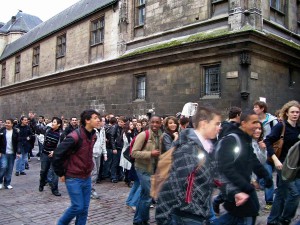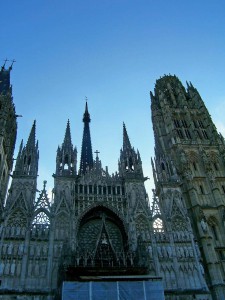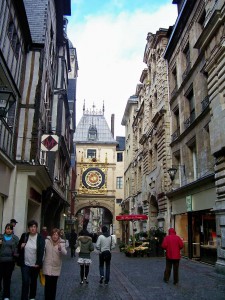FROM PARIS TO NORMANDY ON THE SEINE – ROUEN
FROM PARIS TO NORMANDY ON THE SEINE
This is the seventh in a series of articles about cruising on the Seine
ROUEN: CAPITAL OF NORMANDY
By Charles N. Stevens
Photos by Dolores Seidman
Being in Rouen, capital of Normandy, is much like being back in Paris with its traffic and bustle. As we are docked near the city streets, a parade of cars whizzes by close to our ship. Trucks, buses, cars and trolleys stream over the city’s five bridges, all of which were bombed into rubble during World War II. Across the river are the Ferris wheels and roller coasters of an amusement park.
We begin a walking tour with an English-speaking native of Rouen who first takes us down streets lined with modern apartment buildings. He tells us that this area was destroyed by bombing and a terrible fire during the war. The apartments were then rebuilt after the war to replace those that were destroyed.
Abruptly we come to the older medieval part of Rouen, the portion not destroyed during the war. Here the streets are narrower, half-timbered houses of the 16th to 18th centuries on both sides. We can determine which are the oldest, since each floor of the 16th century ones protrudes about a foot farther out than the floor below it. As we pass the old houses I notice a woman standing on the sidewalk breaking off pieces of her baguette and popping them into her mouth.
In the midst of the old streets stands the Church of St. Maclou with its flamboyant (flame-like) gothic design of delicate stonework. They had begun work on it in 1434, but it was not consecrated until 1521. On the side, flying buttresses prop up the massive masonry. Even the high steeple is pointed like the tip of a flame.
We hear shouting in a nearby street as we walk on, the strident voices echoing between the medieval buildings. Several hundred students march along the street chanting and yelling, clinching their fists in the air. A leader with a bullhorn eggs them on, barking out the appropriate chants. A police car rolls slowly in front of the group and another follows close behind, keeping order. People don’t seem to pay much attention to them. Most of the marchers look like they are having a good time. We are told they are upset with President Sarkozy’s plan to cut down on the number of teachers and expand the sizes of classes. We wait for them to pass.
The demonstration moving on, their shouts gradually fading away, we continue our walk, passing down a narrow shadowed street beside the imposing Bishop’s Palace. A cart delivering goods to a store clatters over the cobbled stones creating a deafening racket. Joan of Arc was tried for her “crimes” in the Bishop’s Palace.
Just beyond the palace we reach the famous Rouen Cathedral, built in 1250, its façade another example of flamboyant architecture. This is the same façade that Claude Monet painted over and over again in different intensities of light, many of these paintings hanging in fine museums all over the world. Pigeons love all the niches in the stonework where they can rest and coo. The church has the highest spire in France, erected so the cross on top would be visible from anywhere in town. Some of the minor statues on front had been vandalized during religious tensions with the Calvinists.
Inside the cathedral we are treated to the usual gothic verticality, the columns seeming to reach the heavens. Along with this are the usual silver organ pipes, stained glass, echoes, cold and flickering candles. The windows had been blown out during the war, much of this and other damage being inflicted by a British bombing raid in April of 1944. One of the chapels inside is dedicated to Joan of Arc. With a touch of modernity and a desire to keep the parishioners warm, radiant heaters have been affixed to its ancient columns.
Once more outside we gaze at the cathedral’s façade. Over the years much of it has been cleaned, the accumulated gunk of centuries sandblasted away. Now restored, the church looks to us the way it did when medieval congregations first beheld it. Three levels of full-sized statues stand in the midst of its ornate front. The whole façade resembles a great sculpture of carved ivory.
Near where we stand admiring the cathedral, a man leans against a building playing “Besame Mucho” on his accordion. The Latin beat seems out of place, especially when the church bells clash with it.
We move on to Rouen’s famous Archway of the Great clock, still using its 14th century mechanism. Besides being indescribably ornate and beautiful, it still chimes and even indicates the day of the week. It has become the symbol of the city. Near the clock, several men sip small cups of coffee at an outdoor cafe table even though the air is quite chilly—the urge to do this being stronger than discomfort from the cold.
The Normandy Courthouse or Palace of Justice is quite a sight! Its ostentatious architecture, complete with statues, gargoyles and delicate pinnacle, rivals any church. It looks as fragile as those decorated cakes that we see in the patisserie windows, yet it has endured for over four centuries. It is used today just as it has been over the years. Dolores goes inside to see what the court looks like. Unused to tourists, the people inside continuously ask her what she wants. Finally they take her to the ornate courtroom, first passing by unhappy people in a hallway awaiting their trials.
Not far away is modern church dedicated to Joan of Arc. Just outside it stands a sculpted spire with a cross on top marking the spot where Joan of Arc was burned at the stake. Just before entering the church I notice a woman standing in front of a statue of the Virgin Mary. She rings hand bells in front of the statue then sets them down, folds her hands and utters a silent prayer.
Inside the church we admire the wooden sweep of its ceiling, its stained glass and its circular polished wood pews. The walls are white, and light fills the sanctuary, a vivid contrast to the cold, stone, tomb-like feeling of the old churches.
On the way back to the ship we pause before a creperie and watch a young woman prepare a crepe. She pours batter on a circular grill, smoothes it out so that she covers it, then lets it cook. By instinct she knows when to turn it, lifting and flipping it expertly with a spatula. When finished she takes it to the side, slathers it with chocolate, folds it, and hands it to the customer.
In the afternoon Dolores and I walk back into town to visit the Rouen Museum of Art. We enjoy taking our time to admire their collection of French paintings, many of them by well-known Impressionists. We let each one sink into us and feel what it has to say.
Outside the museum in a small park workers set out a dense bed of chrysanthemums, all of them fall colors—yellows and dark shades of red, another example of how important flowers are to the French people.
The afternoon has become sunny, but the air is cool, just right for walking and looking. We note how we can always hear a French woman approaching by the distinct staccato of her heels on the sidewalk. They glide by with their stylish clothes, the sound of their heels actually a part of their appearance. We also note that smoking is still fashionable among the young.
Our ship is much lower when we return as the tidal fluctuations are exaggerated in Rouen since it is near the sea. We’re ready to relax in our cabin after a day of walking then walking some more.

These young students march in protest of larger class sizes ordered by their president.

These young students march in protest of larger class sizes ordered by their president.

The flambouyant Rouen Cathedral was painted many times by Claude Monet.

This famous clock has indicated the time for Rouen's citizens for hundreds of years.

This woman is making a crepe that she will soon slather with chocolate.




Looking for a way to contact Mr Stevens about his Bombardier book.
Plz contact at above email